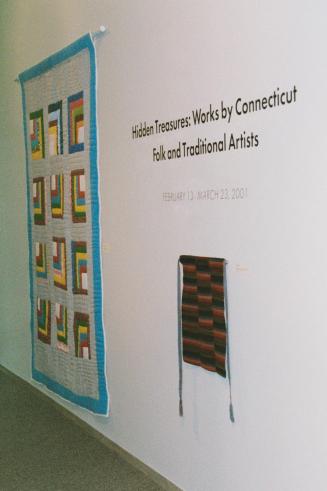Ambassadors of Folk Exhibit Gallery
Date2010-2011
Mediumborn digital video
DimensionsDuration: 18 Seconds
ClassificationsGraphics
Credit LineConnecticut Cultural Heritage Arts Program collections
CopyrightIn Copyright
Object number2015.196.654.2
DescriptionVideo showing the gallery for the exhibition, "Ambassadors of Folk: Connecticut Master Traditional Artists." Jampa Tsondue's artworks are featured in the video.
NotesSubject Note: "Ambassadors of Folk: Connecticut Master Traditional Artists" was an exhibit presented at the Institute for Community Research in Hartford, Connecticut, from June 10 through October 2010. Curated by the Connecticut Cultural Heritage Arts Program, the exhibit showcased the artistry of Connecticut folk and traditional artists who have achieved recognition on a national or international scale. The exhibit brought to wider attention the mastery of local artists who are highly respected exemplars of ethnic traditions within their communities. The eight visual artists and two performers featured represent a wide variety of artistic genres and ethnicities and share a high degree of technical skill and sophistication. The artists’ accomplishments represent entire lives spent serving their communities through cultural production.Artists included Aldona Saimininkas, East Hartford; Romulo Chanduvi, East Hartford; Jampa Tsondue, Old Saybrook; Eldrid Arntzen, Watertown; Paul Luniw, Terryville; Valentine and Aili Galasyn, Canterbury; Shengzhu Chen Bernardin, Torrington; Marek Czarnecki, Meriden; Fatima Vejzovic, Hartford; performers Negrura Peruana, East Hartford and Daniel Boucher, Bristol.
Art forms exhibited drew from roots in Lithuania, Peru, Tibet, Norway, Ukraine, Finland, China, and Eastern Europe, but were all made and used here in Connecticut and beyond. One unifying characteristic is that these pieces have been created for use in a community’s traditional practices. For example, the Buddhist thangka paintings and the Byzantine Christian icons encourage active veneration, they serve a purpose beyond being paintings to be viewed. Other forms on display include decorative containers, cloth, commemorative pictures and rugs, wood carvings, and important seasonal decorations such as two types of dyed and etched Easter eggs. Performance traditions originate from African Peru and Québec. All of the art forms are beloved in the artists’ communities in Connecticut, where they serve as important expressions of cultural identity and heritage.
This exhibit celebrated the twenty years that the Connecticut Cultural Heritage Arts Program has worked with these and other remarkable traditional artists and their communities across the state.
Biographical Note: Jampa Tsondue was born in 1959, just after his parents arrived in India, having left their farmland in Shigatse near Lhasa. Settling in Darjeeling, the family was visited by a monk-painter who noticed Jampa's talent. After school each day from the age of thirteen Jampa took art lessons from this teacher, Ngawang Norbu. Later Jampa moved south to Mysore to become an apprentice to this famous painter at the Gyudmed Tantric University, studying techniques of thangka painting for five years. The bond between master teacher and student can become very strong, almost familial. Jampa worked with his teacher, who also lived with the family, for the next fifteen years. Together they accepted commissions for thangka paintings, murals, and restoration of old art works. Their most important project took four painters nearly four years to complete - recreating forty-one thangkas in the Dalai Lama's collection, each 4 feet by 3 feet, depicting the past lives of the Buddha.
In 1992, Jampa was chosen by lottery to come to America with 1,000 Tibetans, and he settled in Old Saybrook where he still lives. Although working and raising three children, Jampa has completed several thangkas in America although each requires a long process; he does not make them for sale. Every Tibetan has a home altar, and Jampa has created an altar in his house where his thangkas are used by his family for meditation. He has been very active in the Tibetan Association of Connecticut, a social organization that serves the nearly 500 Tibetans that have settled in Connecticut (growing from the 21 who came in 1992). Jampa participates in community gatherings to celebrate Losar, New Year, and the Dalai Lama’s birthday. In February 2007, Jampa’s paintings and drawings were on display at Wesleyan University, at the Mansfield Freeman Center for East Asian Studies, organized by Patrick Dowdey, curator and professor at the Freeman Center. Jampa also did a demonstration of thangka painting there. This was his first exhibition in many years, and his first solo exhibit. Exhibitions and demonstrations featuring Jampa’s work have taken place at Trinity College, Hartford, the "Ambassadors of Folk: Connecticut Master Traditional Artists" exhibit at the Institute for Community Research in Hartford, the "Auspicious Signs: Tibetan Arts in New England" exhibition also at ICR, and an exhibit at the Connecticut Office of the Arts Gallery that celebrated 25 years of the Connecticut Cultural Heritage Arts Program. Jampa has taught his daughter Yangzom to create thangkas. In 2015, Jampa received a Folk Arts Fellowship from the Connecticut Office of the Arts.
Subject Note: Hung in Buddhist monasteries and family shrines, thangkas usually depict spiritual beings. By viewing and meditating deeply upon a thangka, one's own character can become imbued with the qualities of the figure represented, as a way to transform the self. The process of creating a thangka can be a devotional act for the artist.
Religious painting holds great importance in Tibetan Buddhism. Vast stores of Buddhist knowledge and doctrine are written in books housed in monasteries. Paintings both large and small illustrate these texts by depicting central figures and deities, stories of their lives, as well as charts of medical knowledge and elements of doctrine. Tibetan Tantric Buddhism practices visualization as a way to transform the self, to "identify with" Buddha and other deities, and to work toward enlightenment by bringing principles of wisdom and compassion into one's life. By viewing and meditating deeply upon a painting, one's own character can become imbued with the qualities of the figure represented. Both lay people and lamas commission paintings for devotional purposes as well as for aiding health or for teaching Buddhist doctrine.
The usual form of such painting in Tibet is the thangka, a painted scroll which can be rolled up for storage or transport. Thangka painting's origins and influences are complex, going back to 7th century India, with evolution over the centuries affected by Nepali and Chinese styles. Painting methods have also developed over hundreds of years, and are strictly followed by artists. Jampa Tsondue's training included techniques of canvas preparation, mixing pigments, measurement, outlining and drawing of the design, painting, shading, finishing, and mounting. The exquisite care and skill needed to create an authentic thangka make the costs of commissioning one very high. According to religious tradition, thangkas should not be made and sold in a market. Today, however, this does happen. In America, the difficulty of obtaining the right materials, as well as finding time to devote to such labor-intensive art, has been a challenge for Jampa and other artists.
The process of creating a thangka requires several steps. First a piece of pure cotton is hemmed on all sides then stitched to four bamboo sticks, making a flexible frame. These sticks are attached by strong thread to a larger wooden frame which holds the cloth taut and stretches it when the thread is pulled. An animal hide glue is applied to both sides of the cloth, scraping to make sure no particles remain on the surface. After the cloth is stretched and dried, one or two coats of chalk or clay gesso are applied. Jampa then rubs the smooth side of a conch shell over it to press the gesso into the "holes" in the cotton, making the surface like paper. Next, measurements and calculations determine the exact center to create an axis on the canvas for the drawing. An experienced artist like Jampa can draw the design freehand; sometimes for complicated figures a tracing is made from a book or master draftsman's work. Qualities and proportions of all the deities are set out in exquisitely detailed iconographies within Buddhist texts - the artist does not alter these.
After the sketch is outlined in ink, painting begins by applying base colors one at a time. Pigments are natural minerals crushed and mixed with water and herbs, sometimes with a little glue. A variety of shading and toning techniques are used very carefully and subtly throughout the painting. Outlining details are added as well as facial features. Twenty-four carat gold paint is usually applied for patterns on clothes or ornaments, then burnished. The completed thangka is often encased in a silk brocade frame backed by muslin, with bamboo and cedar dowels at top and bottom for hanging or rolling up. Thangkas used in religious ceremonies are consecrated by a lama.
"Our thangka painting is totally related to Buddhism. Most of our thangkas represent someone doing meditations - while they are doing meditations they have to concentrate on whatever the god or goddess is, they focus their minds on it. Also so people know how these gods are - Tara looks like this, Yamantaka looks like that...when you look at a thangka, you feel so good! So calm, peaceful, when you go home you feel better, you have no anger, you're really very peaceful. My teacher used to say that when we do painting, before we start, we have to meditate. Then we have a short prayer...the whole day doing painting is for me a meditation. Once you start it you don't like to have a break...external feelings or thoughts never come in, you just focus on the thangka. It's really a meditation."
Aditional materials exist in the CCHAP archive for this artist and this exhibit.
Cataloging Note: This project was made possible in part by the Institute of Museum and Library Services MA-245929-OMS-20.
Status
Not on view

